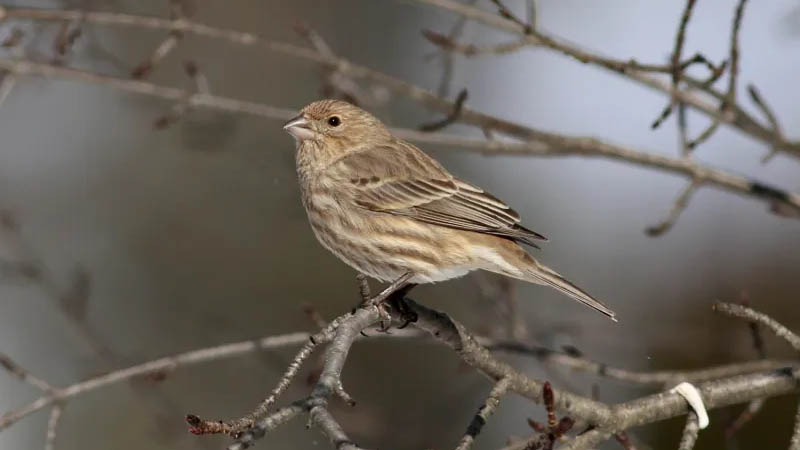House Finch
Haemorhous mexicanus (Müller 1776)

Appearance:
Size: L 6″
Shape: Fairly small, slender, small-headed bird with a generally short stubby coni- cal bill (see Subspecies) and relatively long slightly notched tail. Culmen noticeably curved (mostly straight in Cassin’s and Purple Finches). Similar Cassin’s and Purple Finches have a deeper belly, longer bill, less curved culmen, and are larger-headed and more broad-necked with a shorter, deeply notched tail.
Both Sexes: Lack pale eye-ring.
Adult Male: Variable bright red to orange-red (occasionally yellow) on head, breast, and rump and generally brownish auriculars; whitish belly and flanks strongly streaked with brown; back brownish with indistinct streaks.
Adult Female: Head finely streaked with brown; weak facial pattern; dusky streak- ing on underparts blurry and not strongly contrasting with dull whitish background; no distinct orange-red on plumage, (but a few may show faint tinge of pinkish, yellow, or orange).
1st Winter: Male often has reduced or mottled red on head and upperparts, some reportedly may lack any red; female like adult female.
Juv: (Apr.–Oct.) Brownish with buffy wingbars.
Natural History
One of the most common and numerous birds throughout much of the contiguous United States, southern Canada, and Mexico. From a few California individuals released from a pet store in New York City in 1939, this eastern population has expanded to meet western population. Is found in a variety of habitats including farms, cities, woodlots and more.
Taxonomy
H. m. frontalis (most of N. Am–Baja CA and n.w. Mex). Has on average small bill and duller whitish underparts with less distinct streaking. M. with dull orangish-red or yellow on head and breast. Birds on the Channel Is.,
CA (“clementis”) have large bill. H. m. mexicanus (res. s.c. TX–e. Mex to s. Mex) have large bill, whiter underparts with more noticeable brown streaking.
Birds in c. TX to C–e.c. Mex (“potosinus”) on average are less orange. Note: some 1st-yr. males may lack any reddish, orange, or yellowish coloration, particularly in the Great Basin. More study is needed on plum- age maturation in regard to geographic variation.
Object of study
Flight call variations and genetics and disease (conjunctivitis) across its range.
Flight Call
Calls consist of sharp, single or multiple cheeps, given frequently by both males and females in a variety of contexts, both from perches and in flight. Appear to function primarily as contact calls. Flight calls can be confused with Evening Grosbeak flight calls and some Red Crossbill call types such as Types 1, 2, 6, 7 and 9 (now Cassia Crossbill). The cadence is different from these species though– the House Finch often doesn’t give the call singly like the Evening Grosbeak or in a series of jip-jip-jips like the Red Crossbill.
Irruptions
Non-irruptive, but some migration does occur.



